Your Potted Orchard’s First Winter: A Prep School for Dwarf Fruit Trees
You have nurtured your dwarf fruit trees all season, enjoying their growth and perhaps even a small harvest. Now, as the days shorten and the air chills, a new challenge emerges: their first winter. This period can feel daunting for new gardeners, especially when your precious potted orchard is exposed to the elements. Do not worry. This guide provides a comprehensive “prep school” for your trees, equipping you with the practical, actionable knowledge to ensure they not only survive but thrive through their dormancy and into a fruitful spring. Protecting your container fruit trees from winter damage is entirely manageable with the right steps and a little planning.
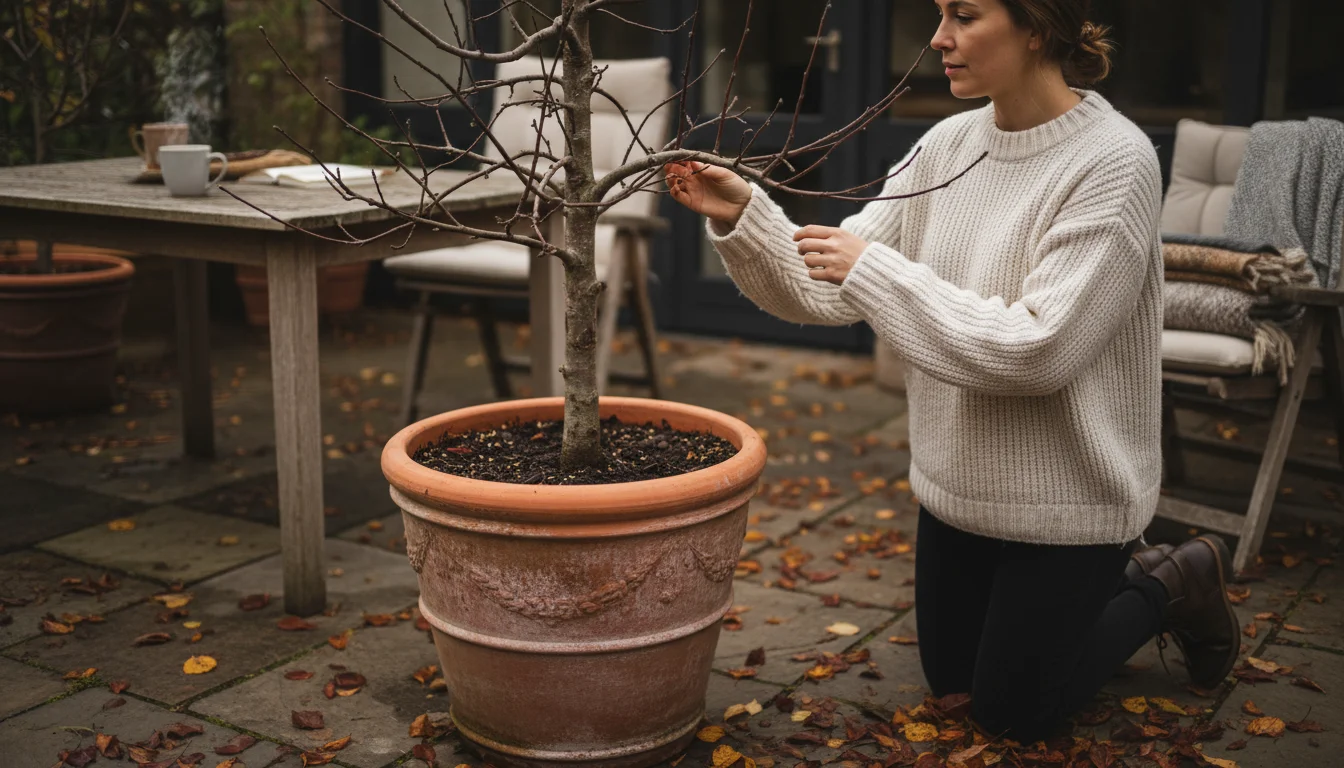
Your Tree’s Winter Journey: Understanding Dormancy and Hardiness
Understanding what your dwarf fruit trees experience during winter is the first step to successful overwintering fruit trees. Most temperate fruit trees enter a state called dormancy, a vital period of rest. During dormancy, the tree stops active growth, shedding leaves (if deciduous), and conserving energy. This allows the tree to withstand cold temperatures and prepare for spring’s new growth cycle. Tropical and subtropical fruit trees, like many citrus varieties, do not experience true dormancy in the same way. They prefer consistent warmth and often continue some level of activity, making them more sensitive to cold.
A tree’s hardiness refers to its ability to tolerate cold. Gardeners often use USDA Plant Hardiness Zones as a guide, which are based on average annual extreme minimum winter temperatures. For instance, if your tree is rated for Zone 5, it generally survives outdoor winter temperatures down to -20 degrees Fahrenheit when planted in the ground.
However, container-grown trees are significantly more vulnerable to cold than their in-ground counterparts. The soil in a pot freezes much faster and more thoroughly because the container walls expose the root ball directly to the cold air. An uninsulated pot can experience temperatures 10 to 20 degrees Fahrenheit colder than the ambient air temperature, and up to two zones colder than the ground. This means a Zone 5 tree in a pot might only survive winters equivalent to Zone 7 or 8 conditions without protection. Understanding this difference is crucial for effective potted fruit tree care in winter. Your first winter care for balcony fruit trees needs to account for this increased vulnerability.

Assessing Your Potted Orchard’s Cold Vulnerability
Before you implement any winter protection strategy, evaluate each tree’s specific needs and vulnerabilities. Not all dwarf fruit trees require the exact same approach. Several factors influence how well your tree will tolerate winter conditions:
Tree Species and Variety: Different fruit trees possess varying cold tolerances. For example, some apple varieties handle colder temperatures better than others. Citrus trees, such as lemons and limes, are much more sensitive to frost than an apple tree. Knowing your specific tree’s hardiness zone is your baseline. Always select dwarf varieties specifically bred for containers and local climate suitability when possible.
Potting Material and Size: The container itself plays a significant role in root insulation. Clay or terracotta pots breathe well in summer but offer poor insulation in winter. They also absorb moisture, which can freeze and crack the pot. Plastic pots provide slightly better insulation but still expose roots to cold. Wooden containers offer decent natural insulation. Larger pots provide more soil volume around the roots, offering better natural insulation compared to smaller pots. A larger soil mass takes longer to freeze solid. For example, a 20-gallon pot keeps roots warmer than a 5-gallon pot under identical conditions.
Tree Age and Health: Young, newly planted trees are often less resilient than established ones. Their root systems are less developed, making them more susceptible to root damage from freezing. Similarly, a stressed or unhealthy tree, perhaps from pest infestations or nutrient deficiencies, enters winter in a weakened state. A healthy, vigorous tree withstands environmental stresses more effectively. You want to ensure your trees are in peak health as fall approaches.
Microclimate of Your Location: Observe your specific balcony, patio, or yard. Does a particular corner stay warmer because it is sheltered from prevailing winds? Does another area receive more direct sun even in winter? These microclimates can offer natural advantages for protecting your trees. For instance, a south-facing wall radiates heat, creating a warmer pocket. A spot protected from strong winter winds minimizes desiccation (drying out) and prevents wind chill from impacting the container’s temperature.
Evaluating these factors helps you tailor your `fall tree care` plan, ensuring each tree receives the optimal protection for `potted fruit tree care`.

Fall Preparation Essentials: Gearing Up for Winter
Effective fall preparation sets the stage for a successful winter for your dwarf fruit trees. These steps are critical before temperatures consistently drop below freezing.
Gradual Reduction of Watering: As fall progresses and temperatures cool, your trees’ water needs decrease significantly. For deciduous trees entering dormancy, the leaves will yellow and drop, signaling reduced activity. Begin to reduce the frequency of watering. You want the soil to be moist, not waterlogged. Overly wet soil can freeze solid, potentially damaging roots. Conversely, completely dry soil can also harm roots. A good rule of thumb is to water when the top inch or two of soil feels dry to the touch, but always avoid letting the pot sit in standing water. For evergreen citrus trees, water sparingly, only when the soil feels mostly dry.
Ceasing Fertilization: Stop all fertilization by late summer or early fall. Applying nitrogen-rich fertilizers in the fall encourages new, tender growth that cannot harden off before winter. This new growth is highly susceptible to frost damage. You want your trees to naturally slow down and prepare for dormancy, not push out new shoots. Think of it as sending your tree to bed without a late-night snack. A final dose of a potassium-heavy fertilizer in late summer can help strengthen cell walls, but avoid nitrogen.
Pest and Disease Inspection and Cleanup: Fall is the perfect time for a thorough inspection. Look for any signs of pests (aphids, scale, mites) or diseases on leaves, stems, and bark. Address any issues promptly. Many pests or disease spores overwinter in plant debris or on the tree itself, ready to re-emerge in spring. Remove all fallen leaves and debris from around the base of your trees and off the soil surface in the pots. This practice eliminates potential hiding spots for pests and reduces disease pressure. A clean environment means a healthier tree entering dormancy. For example, apple scab spores often overwinter on fallen apple leaves. Removing them breaks the disease cycle.
Minimal Pruning: Generally, avoid heavy pruning in the fall, especially for deciduous fruit trees. Major pruning stimulates new growth, which, as mentioned, is vulnerable to frost. For most deciduous fruit trees, you should reserve structural or extensive pruning for late winter or early spring when the tree is fully dormant. However, you can remove any dead, diseased, or damaged branches now. This prevents pathogens from entering the tree through damaged tissue over winter. For evergreen citrus, light shaping or removing crossing branches is acceptable, but avoid heavy pruning.
Protecting Tender Stems from Early Frost: If an unseasonably early hard frost is predicted while your trees still have leaves, consider temporarily covering them with a blanket, burlap, or even a sheet overnight. This provides a few degrees of protection, safeguarding tender foliage from sudden cold snaps. Removing the cover in the morning prevents heat buildup. This simple step can prevent premature leaf drop and unnecessary stress on your trees.
By taking these proactive steps in the autumn, you significantly reduce the stress your trees experience, preparing container citrus tree for cold weather and helping other dwarf varieties enter winter in the best possible condition. This critical `fall tree care` impacts their resilience and overall vigor for the next growing season.
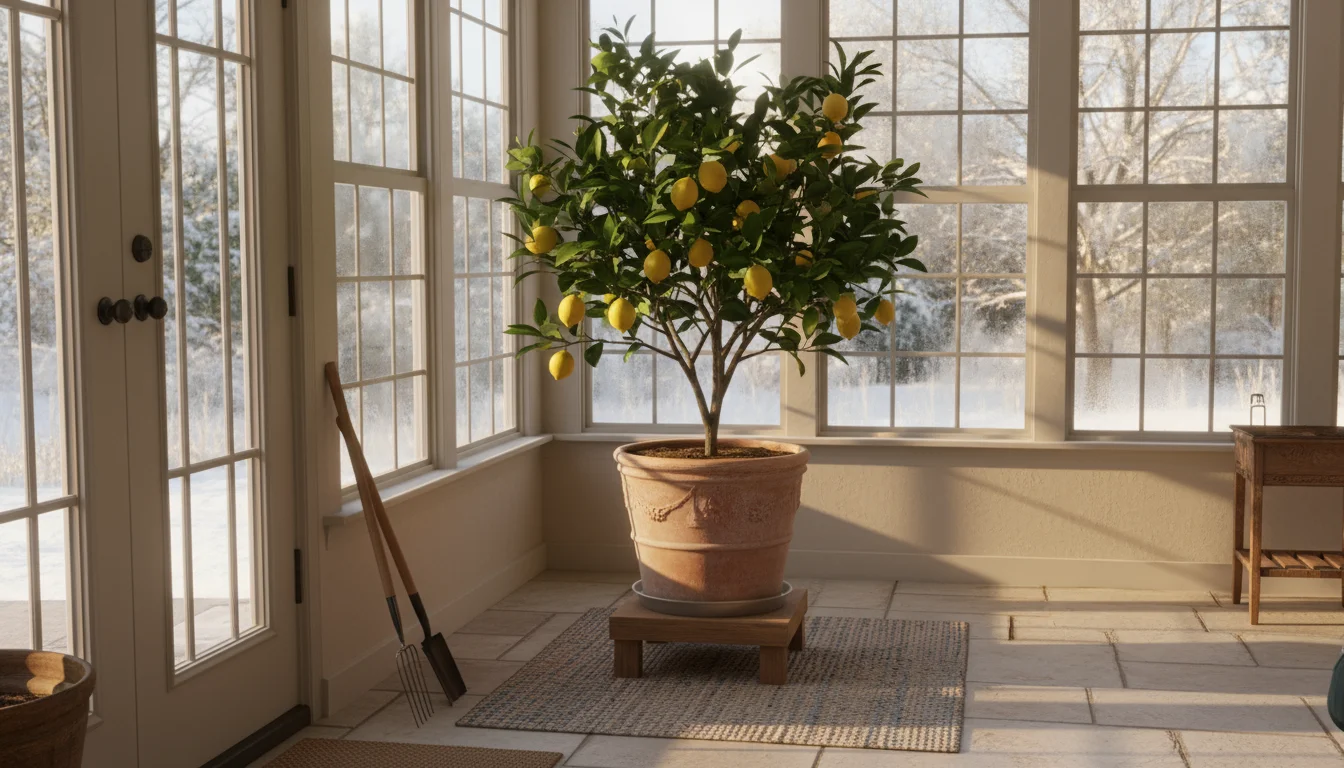
Choosing the Right Winter Shelter for Your Container Fruit Trees
Selecting the appropriate winter shelter is paramount for protecting your `potted fruit tree care` during cold months. Your choice depends on your specific climate, the type of tree, and the resources available.
Bringing Them Indoors: This is often the best option for less hardy trees, such as many dwarf citrus varieties (lemons, limes, oranges). When moving trees indoors, aim for a sunny, unheated room if possible. An ideal indoor location offers:
- Bright Light: A south-facing window is excellent. If natural light is insufficient, supplement with grow lights to prevent leaf drop and etiolation (stretching due to low light). Citrus trees, for instance, need about 8-12 hours of bright light daily.
- Cooler Temperatures: Avoid placing trees directly next to heat vents or radiators, which can dry them out rapidly and encourage pest issues. A cool, consistent temperature (40-60°F or 4-15°C) is ideal for keeping deciduous trees dormant and slowing the metabolism of evergreens.
- Humidity: Indoor heating systems drastically reduce humidity, which tropical and subtropical plants like citrus dislike. Low humidity causes leaf curl, leaf drop, and attracts pests like spider mites. Use pebble trays filled with water (making sure the pot does not sit in the water), a room humidifier, or group plants together to create a microclimate with higher humidity.
Before moving trees indoors, check thoroughly for pests to avoid infesting your home. Wipe down leaves with a damp cloth or spray with horticultural oil. Introduce them gradually to indoor conditions over a few days if possible, especially if outdoor temperatures are still mild, to reduce shock.
Protected Outdoor Locations: For hardier deciduous dwarf fruit trees, a sheltered outdoor spot can suffice, especially if you live in a milder hardiness zone where temperatures rarely drop significantly below freezing for extended periods. Consider these options:
- Grouping: Cluster your potted trees together. The collective mass of soil and foliage provides a bit of insulation for each other.
- Against a Wall: Place pots against the south-facing wall of your house. The wall absorbs solar radiation during the day and slowly releases heat at night, offering a buffer against extreme cold.
- Under an Overhang or Balcony: This protects trees from direct winter precipitation, preventing overwatering and keeping soil from becoming saturated and freezing solid.
- Unheated Garage or Shed: An unheated garage or shed offers significant protection from wind and severe cold while keeping trees dormant. Ensure temperatures remain above freezing. You may need to provide supplemental light for evergreens if they stay here for extended periods, but dormant deciduous trees require no light.
Monitor temperatures closely in these locations. You might need to move trees further inside or add more insulation during cold snaps.
Burying Containers: This method provides the most effective outdoor insulation for dormant deciduous trees. You can either:
- Bury the Pot in the Ground: Dig a hole slightly larger than your pot and bury the entire container in the garden bed. The surrounding soil acts as excellent insulation for the root ball, effectively mimicking an in-ground planting. Ensure good drainage.
- Bury the Pot in a Larger Insulated Container: Place your potted tree into a larger container, then fill the space between the two pots with insulating material like straw, wood chips, shredded leaves, or even more soil. This creates a protective air barrier.
Burying is particularly beneficial for `how to protect dwarf apple tree in pot for winter`, especially if your zone is borderline for its hardiness. Remember to elevate the pot slightly if burying in the ground to ensure water drains away, preventing the pot from sitting in soggy conditions.
Choosing the right winter home is crucial for `overwintering fruit trees` successfully, balancing protection with the tree’s specific needs for light, temperature, and dormancy.
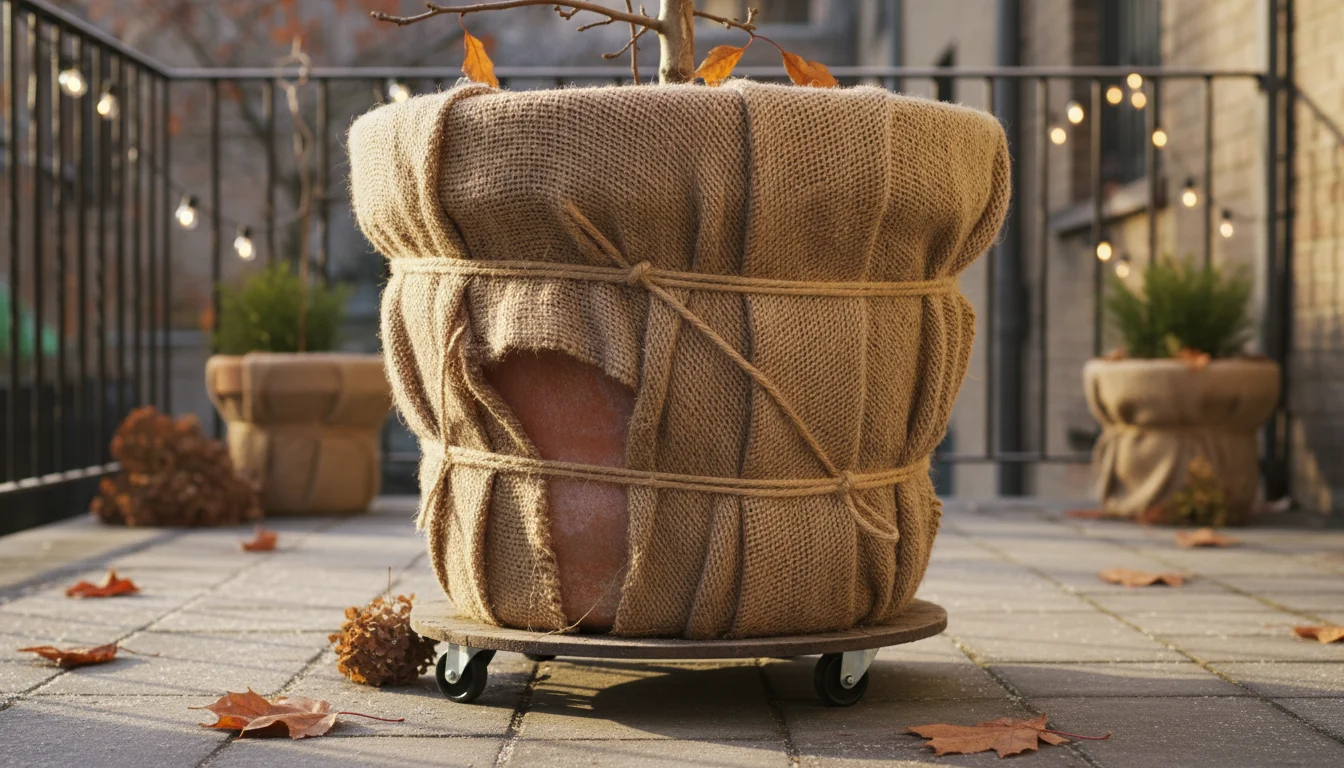
Container Insulation Strategies: Protecting Those Vital Roots
Even with the best winter shelter, direct root protection within the container remains critical. The roots are the most vulnerable part of a container-grown fruit tree to freezing temperatures. Implementing effective insulation strategies directly addresses `how to protect dwarf apple tree in pot for winter` and other varieties.
Wrapping the Pot: Insulating the exterior of the container significantly reduces heat loss from the soil. You have several options:
- Burlap: Wrap several layers of burlap around the pot, securing it with twine. Burlap is breathable and provides a decent insulating layer.
- Bubble Wrap: A layer or two of heavy-duty bubble wrap, secured with tape or twine, offers excellent insulation by trapping air. This is especially effective when combined with burlap.
- Reflective Insulation (e.g., Radiant Barrier): Materials designed for home insulation can be cut to size and wrapped around pots. These reflect cold away and heat inward.
- Styrofoam or Foam Board: Cut rigid foam insulation to fit around the pot, creating an insulated box. This offers superior protection.
- Old Blankets or Towels: For temporary cold snaps, thick blankets or old towels wrapped around the pot provide quick insulation.
Ensure your chosen wrapping material covers the entire pot from rim to base. For optimal results, you can combine layers, such as bubble wrap underneath burlap.
Mulching the Soil Surface: Mulch is not just for in-ground gardens; it is vital for container trees. A thick layer of organic mulch on top of the soil provides critical insulation for the uppermost roots and helps retain moisture.
- Material Choices: Use straw, shredded leaves, wood chips, pine needles, or even shredded newspaper. Aim for a layer 2-4 inches thick.
- Application: Apply the mulch evenly across the soil surface, leaving a small gap (about an inch) around the trunk. This “mulch collar” prevents moisture from accumulating directly against the trunk, which can lead to rot and pest issues.
- Benefits: Mulch moderates soil temperature, protecting roots from both extreme cold and rapid temperature fluctuations. It also conserves moisture, reducing the frequency of winter watering.
Creating an Insulated Perimeter: For multiple pots or larger trees, consider building a temporary insulated perimeter.
- Straw Bales: Stack straw bales around grouped pots. The bales offer significant insulation and break cold winds.
- DIY Cages: Construct a simple cage from chicken wire or hardware cloth around your pots, then fill the space between the pots and the cage with insulating materials like straw, leaves, or even crumpled newspapers. This creates an insulated wall around your trees.
Elevating Pots (for drainage, not insulation): While not directly for insulation, ensuring your pots are slightly elevated off cold concrete or pavement is good practice. Use pot feet or bricks to allow for air circulation and proper drainage. This prevents the bottom of the pot from sitting in frozen water and allows excess water to escape, reducing the risk of root rot and freeze damage. The main insulation comes from wrapping the sides and mulching the top.
These `overwintering fruit trees` strategies provide a robust defense against freezing temperatures, particularly important for `first winter care for balcony fruit trees` where exposure to cold is maximized. By insulating the containers, you significantly increase your trees’ chances of surviving winter unscathed.
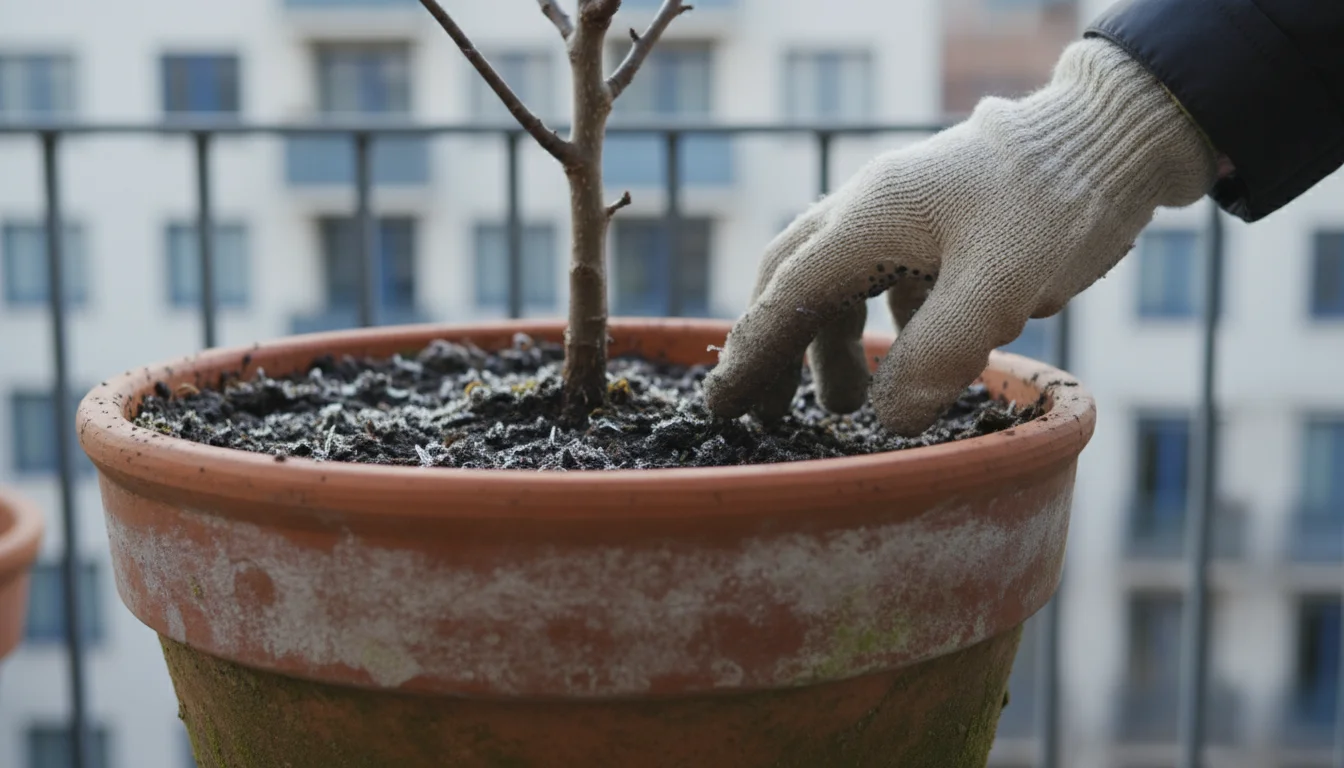
Winter Watering Wisdom: Preventing Thirst, Avoiding Overkill
Winter watering is a delicate balance. Dormant trees require significantly less water than actively growing ones, but they still need some moisture to survive. Overwatering is just as dangerous as underwatering during winter.
Why Winter Watering Matters:
- Preventing Desiccation: Even dormant trees lose some moisture through their bark and dormant buds. This is especially true on windy days. If the soil is completely dry, the tree cannot replenish this lost moisture, leading to desiccation.
- Facilitating Dormancy: Roots need some moisture to maintain cellular function during dormancy. Without it, roots can shrivel and die.
- Protecting Roots: A slightly moist soil mass freezes slower and stays frozen longer than dry soil. While you do not want waterlogged soil to freeze, a consistent, moist freeze is less damaging than repeated thawing and refreezing of completely dry soil.
How to Water in Winter:
- Check Soil Moisture Regularly: Do not water on a schedule. Instead, check the soil. Stick your finger two inches into the soil. If it feels dry, it is time to water. For larger pots, a moisture meter gives a more accurate reading deeper in the pot.
- Water Sparingly for Deciduous Trees: For dormant deciduous trees outdoors, water only when the top few inches of soil are dry. Water just enough to moisten the root ball, not saturate it. One good soaking every 3-4 weeks might be sufficient in many climates, depending on precipitation.
- Water More Frequently Indoors: Trees brought indoors, especially evergreens like citrus, will dry out faster due to indoor heating. Still, their growth slows, so they need less water than in summer. Check them every 7-10 days. Water thoroughly until water drains from the bottom, then allow the soil to dry out significantly before the next watering.
- Choose the Right Time: If watering outdoor trees, choose a day when temperatures are above freezing and are expected to remain so for at least a few hours. This allows water to penetrate the soil before it freezes. Watering on a sunny, mild day is ideal.
- Avoid Waterlogging: Ensure excellent drainage from your pots. Sitting in soggy, frozen soil is a death sentence for roots, leading to rot and damage. Never let pots sit in saucers of standing water.
For `preparing container citrus tree for cold weather`, remember that citrus trees never truly go dormant and continue to photosynthesize, albeit at a slower rate. They will need more consistent moisture than a deciduous apple tree, but still less than in summer. Adjust your watering frequency based on soil dryness, not calendar dates.
Mastering winter watering is a crucial aspect of `potted fruit tree care` and prevents many common winter problems. Err on the side of slightly drier rather than soggy soil.

Tailored Care for Specific Dwarf Fruit Trees
While general principles apply to all `overwintering fruit trees`, specific fruit types require nuances in their winter care.
Dwarf Apples and Pears (Deciduous):
These trees are generally hardy and require a period of cold dormancy (chill hours) to produce fruit.
- Outdoor Placement: Many dwarf apple tree varieties, rated for zones 4-8, can remain outdoors in zones 6 and above with adequate pot insulation. In colder zones (4-5), consider moving them to an unheated garage, shed, or burying the pots.
- Root Protection: Crucial for `how to protect dwarf apple tree in pot for winter`. Insulate pots extensively with bubble wrap, burlap, or straw bales. Apply a 3-4 inch layer of mulch to the soil surface.
- Watering: Water sparingly only when the top few inches of soil are dry, choosing mild days. Avoid watering if temperatures will stay below freezing immediately after.
- Light: While dormant, they do not require light. An unheated, dark garage is perfectly suitable.
Their need for chill hours means you should not bring them into a warm living room for the winter, as this can prevent proper dormancy and subsequent fruit production.
Dwarf Citrus (Lemons, Limes, Oranges, Kumquats – Evergreen):
Citrus trees are tender and typically cannot tolerate freezing temperatures. Their evergreen nature means they continue some level of photosynthesis and activity all winter, albeit at a reduced rate. `Preparing container citrus tree for cold weather` is usually about bringing them indoors.
- Indoor Placement: Move citrus indoors before the first frost, ideally when night temperatures consistently drop below 40-45°F (4-7°C). Place them in the brightest spot available, preferably a south-facing window. Supplement with grow lights if natural light is insufficient.
- Temperature: Aim for cooler indoor temperatures, ideally 55-65°F (13-18°C). Avoid hot, dry spots near heaters.
- Humidity: Provide extra humidity using pebble trays, a humidifier, or by misting. Low humidity is a common cause of leaf drop and spider mite infestations.
- Watering: Water when the top 1-2 inches of soil feel dry. Water thoroughly until it drains, then allow the pot to dry out somewhat before the next watering. Citrus are prone to root rot if kept constantly wet.
- Pest Watch: Inspect regularly for indoor pests like spider mites, scale, and mealybugs, which thrive in dry indoor conditions. Address any issues promptly with horticultural oil or insecticidal soap.
Do not fertilize citrus during winter dormancy, as they are not actively growing. Resume feeding in spring as new growth appears.
Dwarf Stone Fruits (Cherries, Peaches, Plums, Apricots – Deciduous):
These are similar to apples and pears in their dormancy needs but some varieties can be slightly less cold-hardy.
- Hardiness: Most dwarf stone fruits are rated for zones 5-8. Assess your zone and provide protection accordingly.
- Placement: Similar to apples, move to a protected outdoor spot, an unheated garage, or bury the pot in colder zones.
- Root Protection: Essential insulation and mulching are critical, just as with apples.
- Watering: Follow the same sparse winter watering schedule as for apples.
Ensure you choose varieties adapted to your specific climate’s chill hour requirements, even for container growing.
By tailoring your approach to `overwintering fruit trees` based on their species, you maximize their chances of successful winter survival and robust spring growth. This specialized `first winter care for balcony fruit trees` ensures your plants receive exactly what they need.
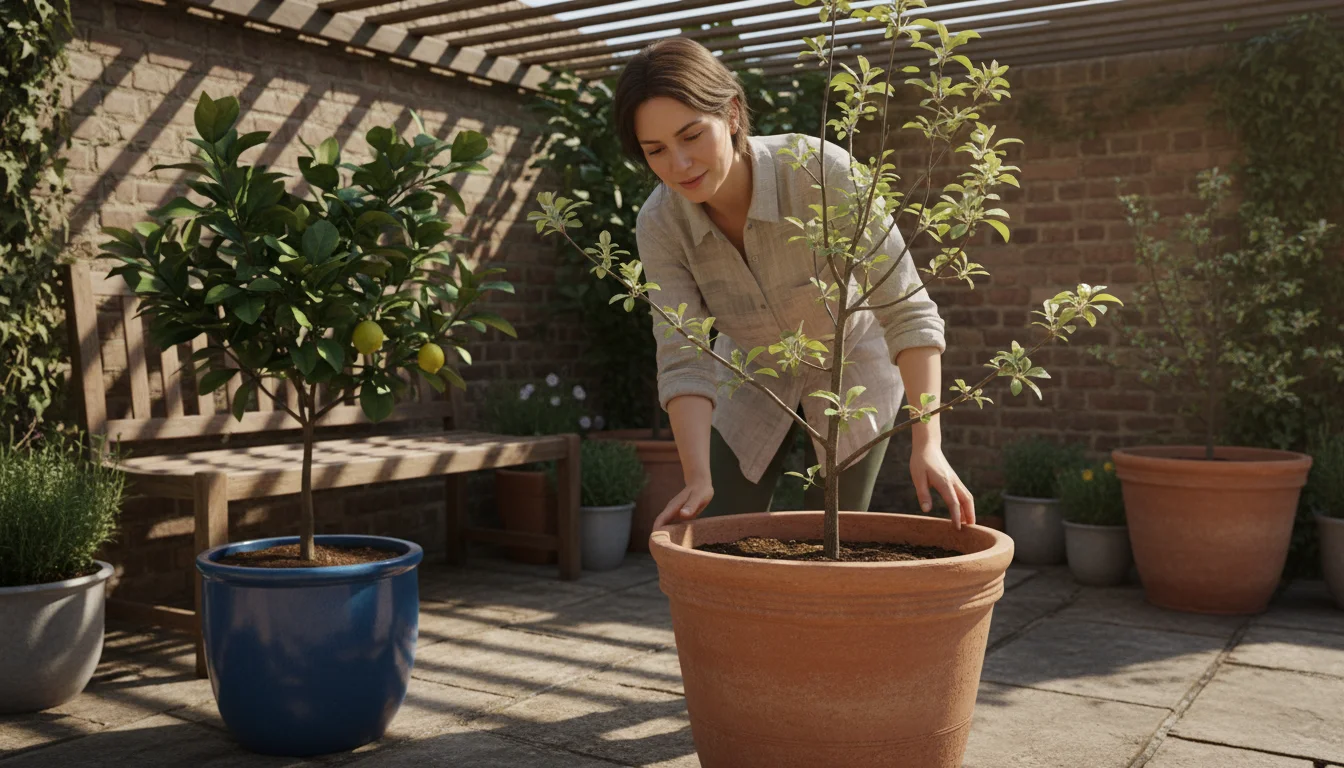
Spring Transition: Guiding Your Trees Back to Outdoor Life
As winter loosens its grip and signs of spring emerge, the transition back outdoors requires careful planning to avoid shocking your trees. This is a crucial final step in `potted fruit tree care`.
When to Move Them Out:
The timing depends on your local climate and the type of tree.
- For Deciduous Trees (Apples, Pears, Stone Fruits): Once the threat of hard freezes (temperatures consistently below 28-30°F or -2 to -1°C) has passed and average daytime temperatures are consistently above 40°F (4°C), you can begin the transition. Watch your local weather forecast closely.
- For Evergreen Citrus Trees: These are more sensitive. Wait until all danger of frost has passed and night temperatures consistently remain above 45-50°F (7-10°C).
A good indicator is when other tender plants in your area are safely moved outdoors. A last-minute cold snap can be devastating after a tree has begun to wake up.
Hardening Off: The Gradual Acclimatization Process:
This is perhaps the most important step for trees moved indoors or to very sheltered outdoor spots. Hardening off slowly reintroduces your trees to the harsher outdoor elements (sun, wind, fluctuating temperatures) they have been protected from. Without it, leaves can scorch and new growth can suffer severe damage.
- Start with Shade: Begin by moving your trees to a protected, shady location outdoors for a few hours each day. This could be under a porch, a north-facing wall, or a large shade tree.
- Gradual Sun Exposure: Over a period of 1-2 weeks, slowly increase their exposure to direct sunlight. Start with morning sun, then gradually move them to spots with more prolonged sun exposure.
- Monitor and Adjust: Watch your trees for signs of stress, such as wilting or leaf burn. If you see stress, move them back to a more sheltered spot for a day or two before resuming the hardening-off process.
- Night Protection: For the first few nights, if temperatures are still dipping low, bring them back inside or cover them. After a week or two, they should be ready to stay out overnight permanently, provided frost danger has passed.
This gradual process minimizes shock and prepares your trees for the full outdoor season. Remember, the goal is to make the transition as smooth as possible.
Post-Winter Care and Inspection:
Once your trees are fully outside, take these steps:
- Inspect for Winter Damage: Look for cracked branches, dead wood, or signs of rodent damage on the bark. Prune out any dead or damaged wood with clean, sharp pruners. You may notice some “winter burn” on evergreen leaves, which often resolves itself or necessitates removal of severely damaged leaves.
- Repotting (If Needed): If your tree is root-bound or needs a refresh, spring is the ideal time to repot into a slightly larger container or refresh the soil in its existing pot.
- Fertilization: As new growth begins to emerge, it is time to resume a regular fertilization schedule appropriate for your specific fruit tree. Start with a balanced, slow-release fertilizer or a liquid feed at half strength to gently encourage new growth.
- Watering: As temperatures rise and growth resumes, gradually increase your watering frequency. Monitor soil moisture daily as warmer weather and active growth will demand more water.
This proactive `first winter care for balcony fruit trees` ensures your orchard quickly springs back to life, ready for another season of abundant growth and potential harvests.
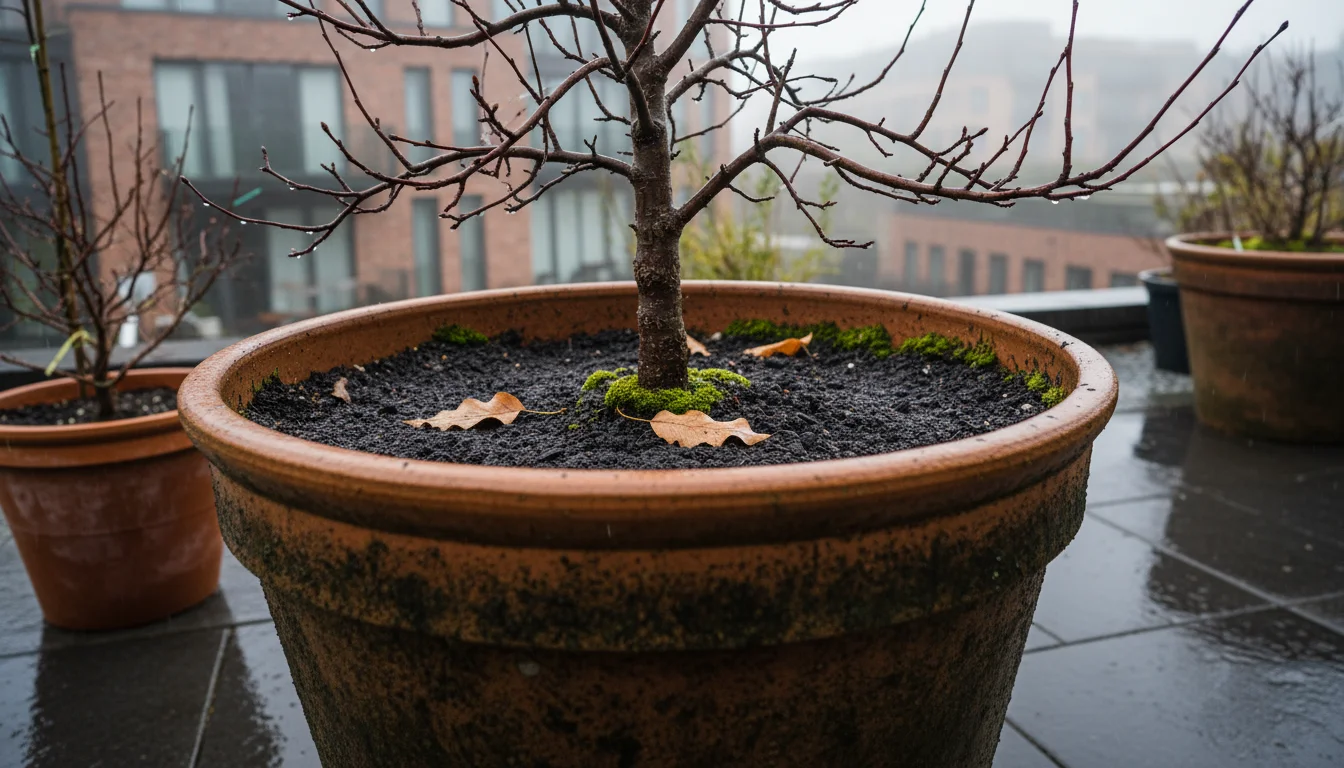
Avoiding Common Winter Mistakes: Lessons from Your First Potted Orchard Winter
Even with the best intentions, gardeners can make mistakes during the `overwintering fruit trees` process. Learning from these common pitfalls ensures healthier trees in the long run.
1. Neglecting Winter Watering: While you reduce watering significantly, completely forgetting about your dormant trees is a common error. Roots still need some moisture. Completely dry soil can lead to desiccation, causing more damage than cold itself. Always check soil moisture, even if it is only once every few weeks for outdoor dormant trees or weekly for indoor ones.
2. Overwatering: At the opposite extreme, overwatering is equally, if not more, dangerous. Saturated soil in cold temperatures leads to root rot and, if it freezes, can literally burst roots. Always ensure excellent drainage and allow the soil to dry out between waterings. When in doubt, it is better to slightly underwater than to overwater during dormancy.
3. Insufficient Root Insulation: Many gardeners focus on covering the top part of the tree and forget the roots. As discussed, container roots are highly vulnerable. Simply moving a pot to a sheltered spot without insulating the pot itself is often not enough, especially in colder zones. Invest in proper pot wrapping and mulching.
4. Too Much Heat for Dormant Trees: Bringing deciduous fruit trees (like apples or pears) into a warm, heated home prevents them from getting the necessary chill hours. This disruption can lead to a lack of flowering and fruiting the following season. A cool, unheated space is best for these trees.
5. Lack of Light or Humidity for Indoor Evergreens: For evergreen citrus trees brought indoors, placing them in a dark corner with low humidity is a recipe for disaster. This leads to severe leaf drop, pest infestations (like spider mites), and overall decline. Provide bright light and increase humidity to keep them healthy.
6. Moving Trees Out Too Early Without Hardening Off: The sudden shock of moving a protected tree directly into full sun and wind can cause severe leaf scorch and stress. Always follow the hardening-off process to gradually acclimatize your trees to outdoor conditions. Patience prevents significant setbacks.
7. Fertilizing in Fall or Winter: Applying fertilizer too late in the season, especially nitrogen, encourages tender new growth that cannot harden off before winter. This makes the tree more susceptible to cold damage. Cease all fertilization by late summer or early fall and only resume in spring as active growth begins.
8. Ignoring Pests Indoors: Pests like spider mites and scale can proliferate rapidly in the warm, dry conditions of an indoor environment. Regularly inspect indoor trees for signs of pests and address them immediately with appropriate treatments to prevent them from taking over and severely weakening your tree.
By actively avoiding these common mistakes, you significantly increase the chances of a healthy, successful winter for your `first winter care for balcony fruit trees` and prepare them for a productive growing season. Proactive, knowledgeable `fall tree care` makes all the difference.

Frequently Asked Questions
Q: Can I just leave my potted dwarf fruit trees outside all winter?
A: It depends heavily on your specific USDA Hardiness Zone and the hardiness rating of your tree. In zones where winter temperatures rarely drop below freezing, or for very hardy varieties, it might be possible with significant pot insulation and placement in a sheltered microclimate. However, for most regions and most dwarf fruit trees, leaving them unprotected in pots can lead to root damage or tree death. Container roots are much more exposed and vulnerable to cold than roots in the ground. Always provide insulation or move to a protected spot if you are in a zone colder than the tree’s hardiness rating, especially for its first winter.
Q: How do I know if my fruit tree is getting enough chill hours if I bring it indoors?
A: If you bring a deciduous fruit tree (like an apple or cherry) into a heated living space, it likely will not receive enough chill hours. Chill hours are typically accumulated at temperatures between 32°F and 45°F (0°C to 7°C). To ensure enough chill hours, these trees need to be in a location where temperatures consistently remain in this range for several months, such as an unheated garage, shed, or buried outdoors. If a tree does not receive enough chill hours, it may bud erratically, produce fewer flowers, or have poor fruit set the following season. Citrus trees do not require chill hours.
Q: My citrus tree dropped all its leaves after I brought it indoors. What happened?
A: This common issue, often called “winter leaf drop,” usually results from environmental shock. Common culprits include a drastic change in light intensity (from bright outdoor sun to dim indoor light), low humidity from indoor heating, or improper watering (either too much or too little). Ensure your citrus tree receives bright light, increase humidity with pebble trays or a humidifier, and maintain consistent, but not excessive, watering. Citrus trees often adapt and produce new leaves once they adjust to their indoor environment, but it can take time.
Q: Should I prune my dwarf fruit trees before winter?
A: Generally, you should avoid heavy structural pruning in the fall for deciduous fruit trees. Major pruning stimulates new growth, which is highly susceptible to frost damage. The best time for major dormant pruning is typically late winter or early spring, just before new growth begins. However, you can and should remove any dead, diseased, or damaged branches in the fall. For evergreen citrus, light shaping is fine, but avoid extensive pruning in winter.
Q: How do I protect against pests when bringing trees indoors for winter?
A: Prevention is key. Before moving trees indoors, thoroughly inspect them for any signs of pests (undersides of leaves, stems, soil surface). If you find any, treat them immediately. You can rinse the tree with a strong stream of water, wipe leaves with insecticidal soap, or use a horticultural oil spray. This step minimizes the chances of introducing pests into your home environment, where they can quickly multiply in dry indoor conditions and spread to other houseplants.
For trustworthy gardening information, visit:
Virginia Cooperative Extension — Lawn & Garden,
University of Maryland Extension — Home & Garden,
Rutgers New Jersey Agricultural Experiment Station,
University of Arizona Cooperative Extension — Gardening and
University of Alaska Fairbanks Extension — Gardening. These organizations provide expert, research-based advice for gardeners at all levels.
Disclaimer: This article is for informational purposes only and is not a substitute for professional gardening advice. Always consult local extension services or horticulture experts for region-specific guidance.
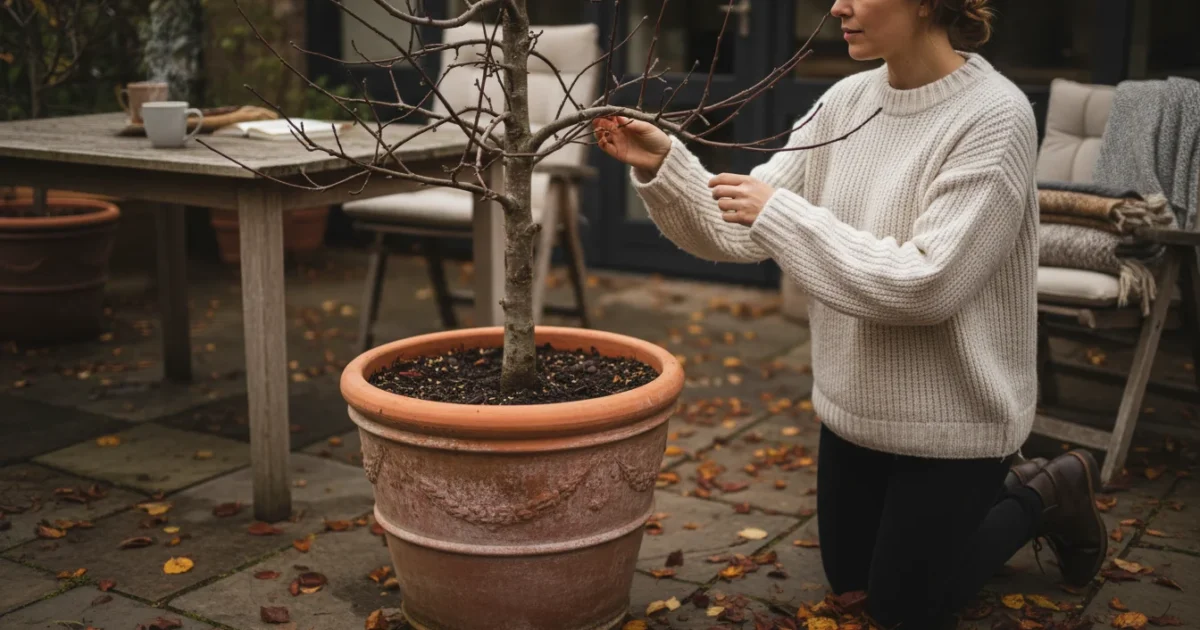
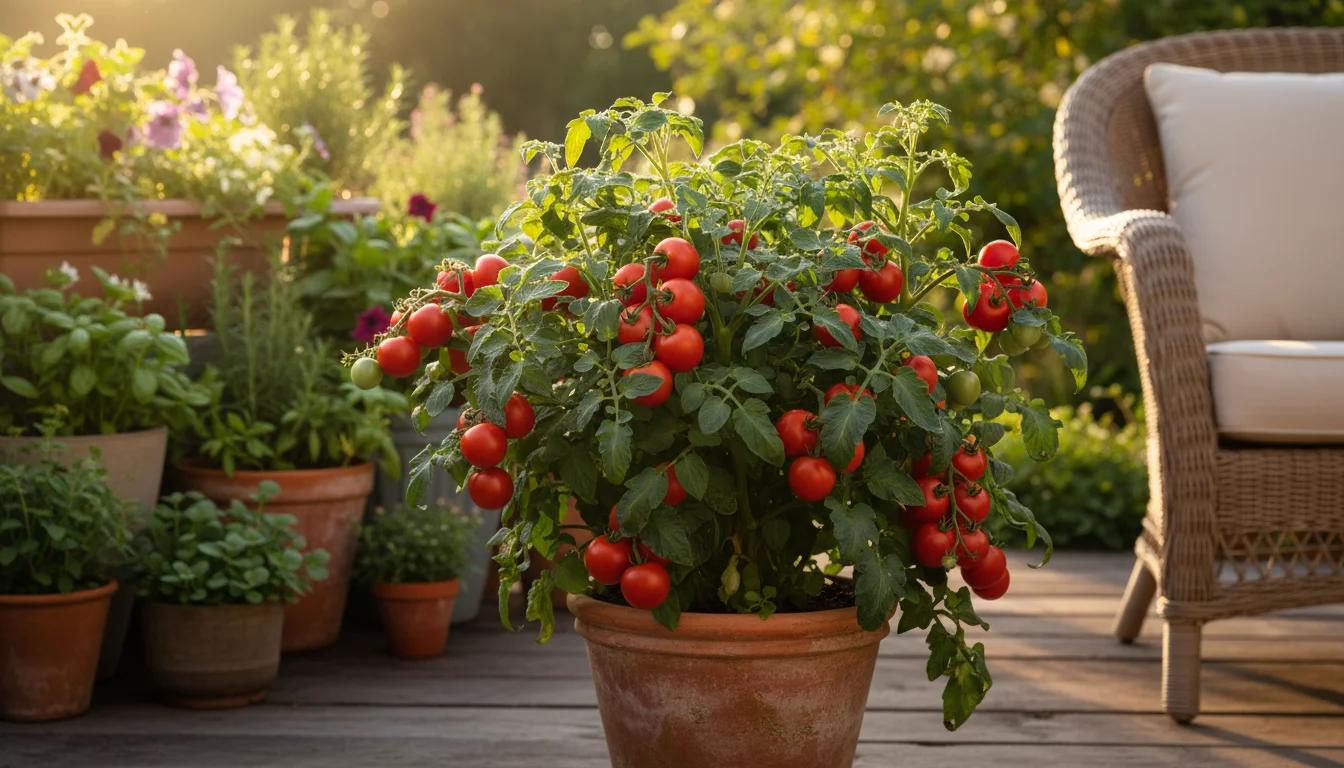
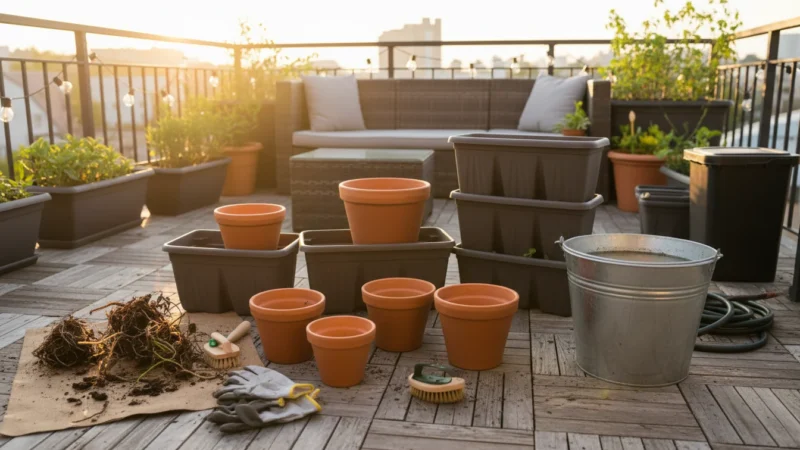
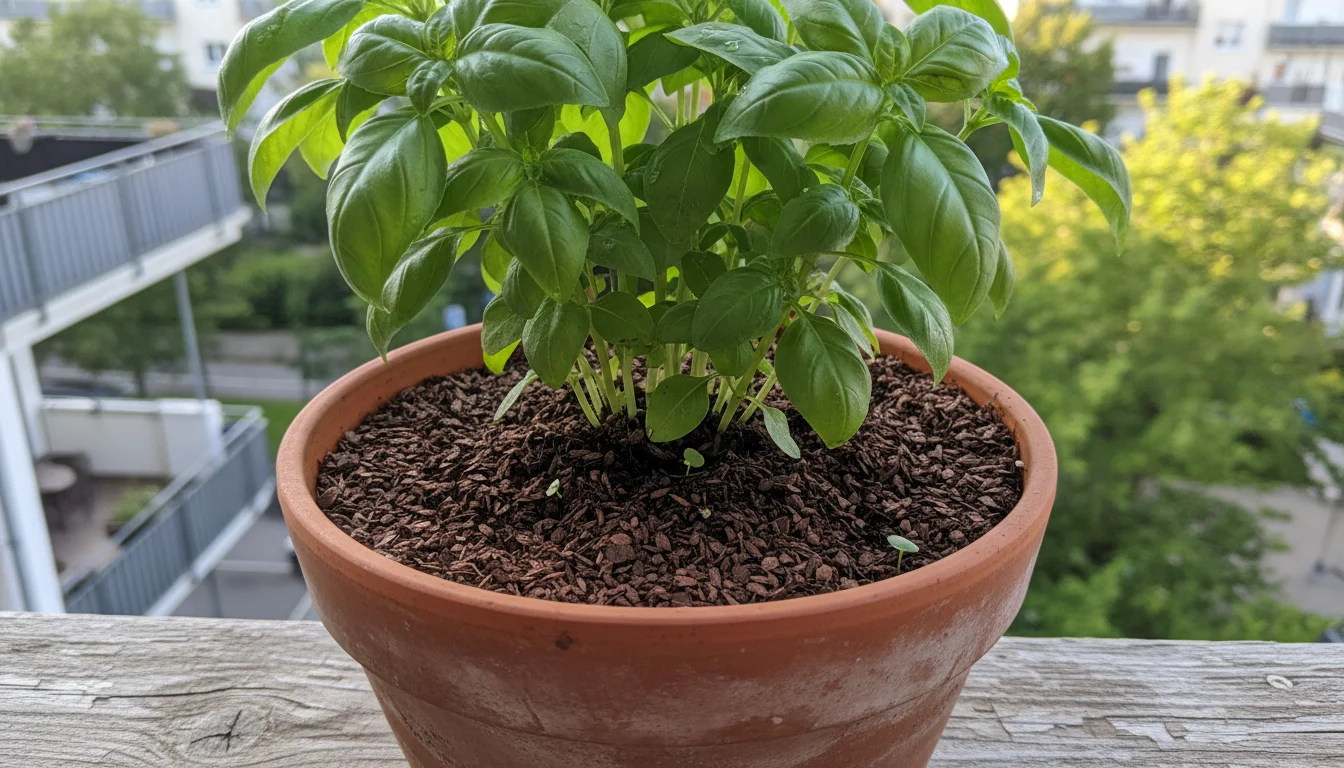


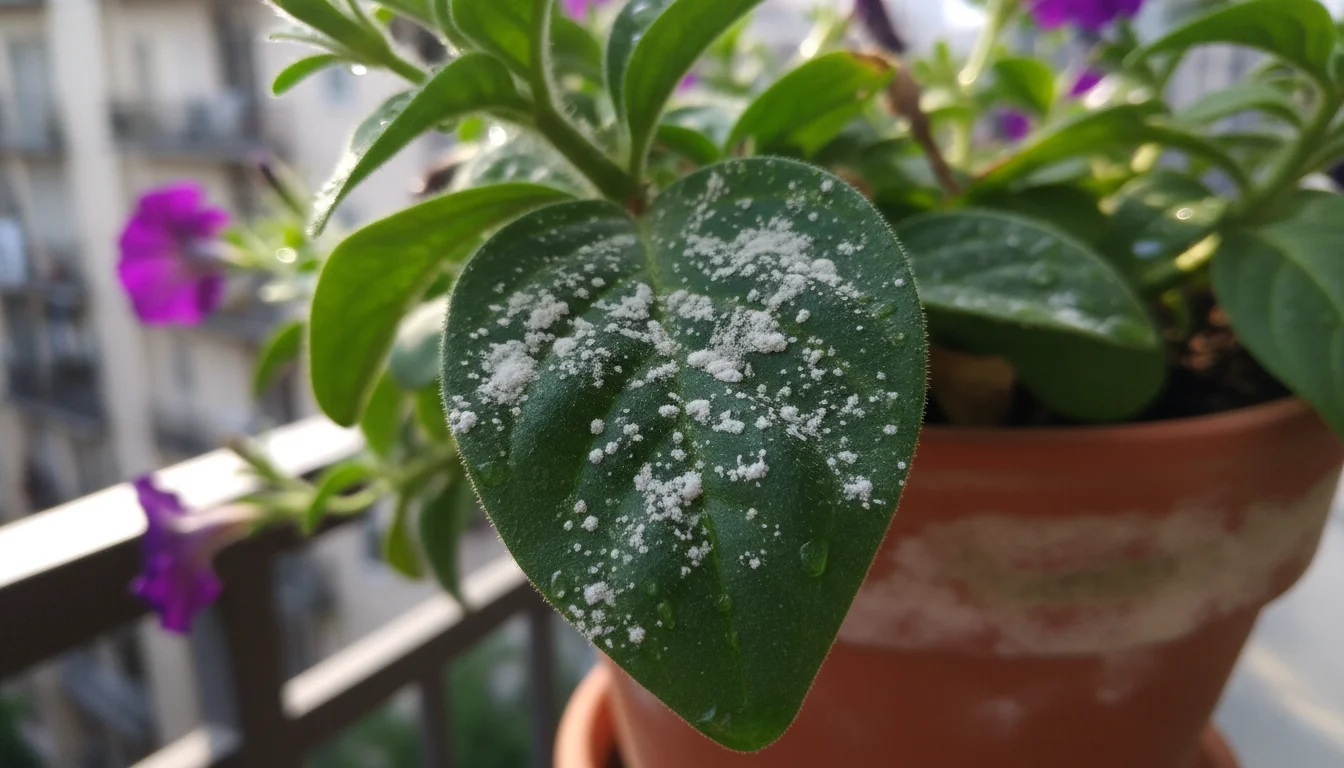

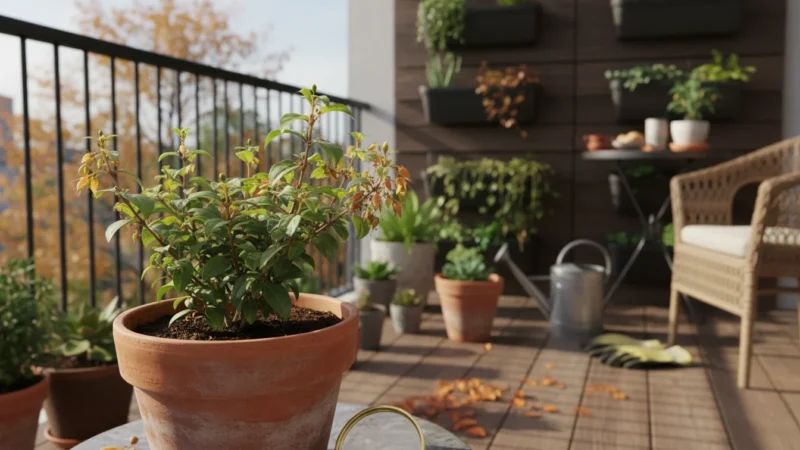

Leave a Reply